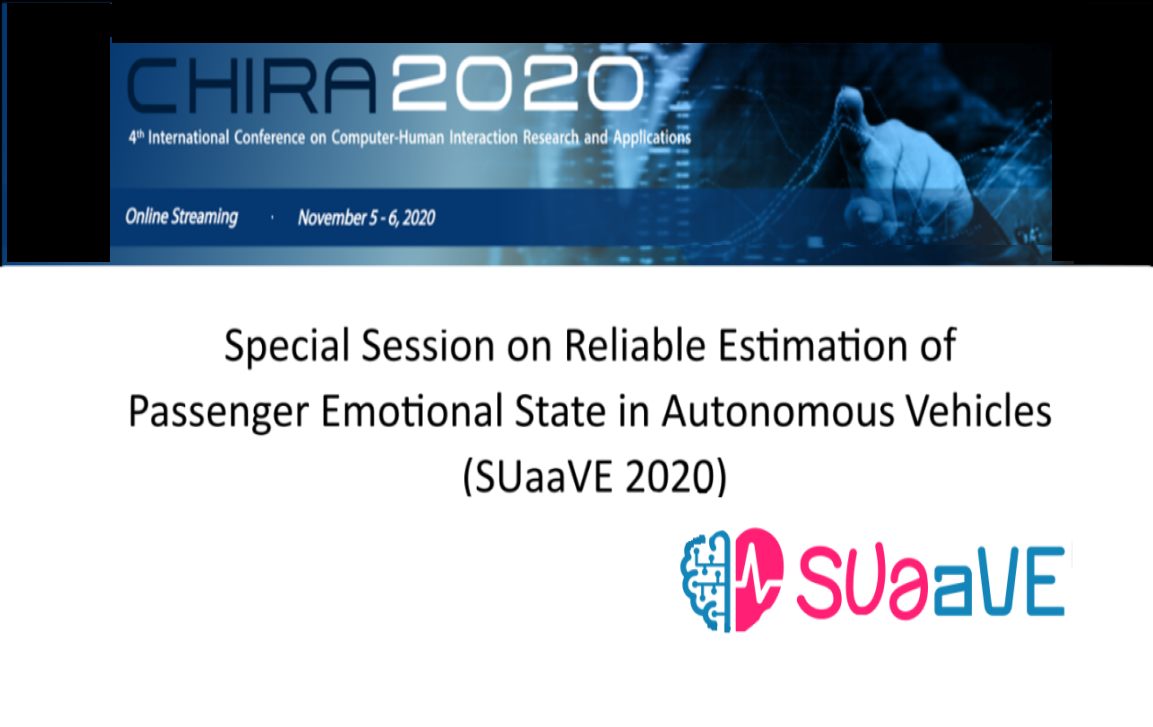The Special Session on “Reliable Estimation of Passenger Emotional State in Autonomous Vehicles (SUaaVE 2020)” was held online November 6th at the International Conference on Computer-Human Interaction Research and Applications 2020 (CHIRA).
In this session, Lucie Lévêque (from Université Gustave Eiffel -IFSTTAR in the past-, one of the SUaaVE’s partners) presented the paper “Development of an Immersive Simulation Platform to Study Interactions between Automated Vehicles and Pedestrians”. The paper focuses on a novel simulation platform, the V-HCD, allowing the conduct of immersive experimentations, both from the pedestrian’s and the driver’s point of view. This platform will be used to study the acceptance of the automated vehicle in SUaaVE, and further to support the human-centred design of a future empathic automated vehicle (AV).

Figure 1: Example of scenario implemented on the V-HCD platform to study the interaction between a pedestrian and an AV with a more or less attentive driver. Université Gustave Eiffel ©.
Juan Felipe Medina-Lee (from the Center for Automation and Robotics, researcher in the project ‘Programmable systems for intelligence in automobiles’ as a member of Autopia program) presented “Traded Control Architecture for Automated Vehicles Enabled by the Scene Complexity Estimation”. The research consists on a novel traded control architecture proposed to enhance the operational domain of the autonomous driving system (ADS) under the premise that vehicles and humans may need to adapt their cooperation level depending on the context.
The third presentation was conducted by Juan-Manuel Belda-Lois (researcher at Instituto de Biomcecánica de Valencia, IBV, the coordinator partner of the SUaaVE project) with the title “The Estimation of Occupants’ Emotions in Connected and Automated Vehicles”. This research covers an initial experiment to identify changes in the emotional state of the occupants in different driving experiences (in a driving simulator and in real conditions) by measuring and analysing the physiological signals of the participants, serving as a basis for the generation of the emotional model. The results showed that it is possible to estimate the level of Arousal and Valence of the participants during the journey from the analysis of ECG, EMG and GSR signals.

Figure 2: HRV along the experiment and emotional components (Arousal and Valence) declared by a co-driver in each event of an urban journey by car. IBV ©.
The last presentation of the session was conducted by Davide Salanitri (from IDIADA, partner of the SUaaVE project) with the title “Evaluation of a New System in Future L4 Vehicles: Use Cases and Methodology for the SUaaVE European Project”. The paper describes the definition process of the use cases in SUaaVE, considering the different factors that characterize them.
Finally, in the session “Interaction Design” at CHIRA 2020, Benjamin Chateau (from CATIE, another SUaaVE’s partner) presented the paper “Exploring Empathetic and Cognitive Interfaces for Autonomous Vehicles”. An interface for automated vehicles capable of informing the user at any time about the road situation and reassuring him/her about the information processed by the vehicle.

Figure 3: Interface overview. CATIE ©.

